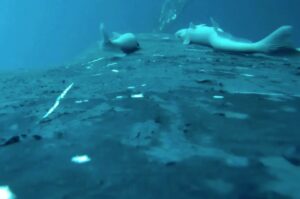Scientists on an Australian research vessel found stunning deep-sea life — some previously undiscovered — while mapping the ocean floor at Cocos (Keeling) Islands Marine Park off Western Australia.

The study area. Map: Geoscience Australia
The research vessel Investigator’s 35-day, 11,000km mission mostly involved mapping the park’s snarled volcanic geography. But a secondary mission to survey the Indian Ocean’s bottom reaped rewards as well.

One of the maps created on the 2022 Investigator voyage. Map: CSIRO, Museums Victoria
“We have discovered an amazing number of potentially new species living in this remote marine park,” said Museums Victoria Research Institute’s Dr. Tim O’Hara in a press release. O’Hara served as the mission’s Chief Scientist.
The Investigator arrived back at port on Nov. 3, and scientists quickly began documenting and photographing the collected samples.

A Sloane’s viperfish, one of the bizarre deep-sea species witnessed by Australian researchers. Photo: Museums Victoria/Benjamin Healley
Notable discoveries
One of the most interesting Investigator discoveries is a blind eel collected from five kilometres underwater. The previously unknown species has gelatinous skin, poorly developed eyes, and gives birth to live young.

A previously unknown species of eel collected on the 2022 Investigator voyage. Photo: Museums Victoria/Benjamin Healley
Some of the other animals the researchers found in the submerged volcanic ecosystem are already known to science. But that doesn’t make them any less interesting.
Deep-sea batfish, for example, have a seemingly puzzled expression on their faces, while Sloane’s viperfish have light organs that attract prey in the otherwise darkened depths.
This journalist’s personal favorite? The Conger eel, which, well, I’ll just let the picture speak for itself.

One of the Conger eels collected by the research vessel. Photo: Museums Victoria/Benjamin Healley
A world of strange creatures
Other deep-sea life surveyed by the expedition include:
- Tribute spiderfish, which scurry across the ocean floor on stilt-like lower fins
- Pelican eels, which have expandable stomachs
- Highfin lizard fish, which in addition to having a face chock full of teeth are also hermaphrodites
- Pancake sea urchins, with their flat skeletons and poisoned-tipped spines
- Slender snipe eels, which can live as deep as four kilometres below the surface

A highfin lizard fish. Photo: Museums Victoria/Benjamin Healley
Scientists from the expedition live-streamed into classrooms around Australia to share their findings, reaching over 850 students. The mission was a collaboration between Museums Victoria Research Institute, CSIRO (the Australian scientific research agency), and other agencies and private organizations.

Dr. Tim O’Hara, Chief Scientist of the 2022 Investigator expedition. Photo: Museums Victoria/Rodney Start






